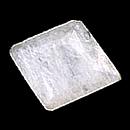|
|
||||||||||||||||
|
||||||||||||||||
|
||||||
|
|
|
|
Barrerite
|
|
| | |
| Discovered in 1974; IMA status: Valid (Approved 1974) | ||
|
| ||
|
Chemistry |
|
|
| |
|
(Na,K,Ca)2Al2Si7O18 Ě 7H2O | |
|
|
Hydrated Potassium Sodium Calcium Aluminum Silicate |
|
Molecular Weight: |
2,680.57 gm |
|
Composition: |
Potassium |
1.55 % |
K |
1.86 % |
K2O |
|
|
Sodium |
4.67 % |
Na |
6.30 % |
Na2O |
|
|
Calcium |
1.26 % |
Ca |
1.76 % |
CaO |
|
|
Magnesium |
0.15 % |
Mg |
0.26 % |
MgO |
|
|
Aluminum |
8.24 % |
Al |
15.58 % |
Al2O3 |
|
|
Iron |
0.02 % |
Fe |
0.03 % |
FeO |
|
|
Silicon |
23.80 % |
Si |
50.93 % |
SiO2 |
|
|
Hydrogen |
1.94 % |
H |
17.33 % |
H2O |
|
|
Oxygen |
58.36 % |
O |
|
|
|
|
|
100.00 % |
|
100.00 % |
= TOTAL OXIDE |
|
|
|
||||
|
Classification |
|
|
| |
|
Silicates (Germanates) | |
|
8/J.23-40 | |
|
|
9 : SILICATES (Germanates)
|
|
Related to: |
Zeolite Group. Heulandite - Barium-Brewsterite Series. |
|
Members of Group: |
Zeolite Group: Amicite, Barrerite, Bellbergite, Bikitaite, Boggsite, Brewsterite, Chabazite, Chabazite-LÚvyne Subgroup, Clinoptilolite, Cowlesite, Dachiardite-Na, Epistilbite, Erionite, Faujasite Subgroup, Ferrierite, Garronite, Gismondine, Gmelinite, Gobbinsite, Goosecreekite, Harmotome, Heulandite, Laumontite, LÚvyne, Mazzite, Merlinoite, Montesommaite, Mordenite, Offretite, Paulingite, Pollucite, Stellerite, Stilbite, Thomsonite, Tschernichite, Wairakite, Willhendersonite, Yugawaralite |
|
Varieties: |
None |
|
Synonyms: |
None |
|
|
|
|
Crystal Data |
|
|
|
|
|
As well-formed, laminar crystals, to 5 mm, with {010}, {011}, and {111}; {001} is common, but of poor quality. |
|
|
None |
|
|
|
|
|
Physical Properties |
|
|
|
|
|
Perfect on {010} |
|
|
Irregular/Uneven, Conchoidal |
|
|
Brittle |
|
|
3.0 - 4.0 |
|
|
2.13 - 2.30 (g/cm3) |
|
|
None |
|
|
Barely Detectable; GRapi = 22.57 (Gamma Ray American Petroleum Institute Units) |
|
|
|
|
|
Optical Properties |
|
|
|
|
|
White, Pink |
|
|
Transparent, Translucent |
|
|
Vitreous |
|
|
1.479 - 1.489 Biaxial ( - ) |
|
|
0.010 |
|
|
None |
|
|
None |
|
|
|
|
|
Occurances |
|
|
|
|
|
Geological Setting: |
On the walls of large fractures in deeply weathered andesitic and rhyolitic lavas. |
|
Common Associations: |
Heulandite |
|
Common Impurities: |
Fe, Mn, Mg, Sr, Ba |
|
Type Locality: |
Near Capo Pula, below South San Efisio Tower, Nora, Margherita di Pula, Cagliari Province, Sardinia, Italy |
|
Year Discovered: |
1974 (IMA approved 1974) |
|
View mineral photos: | |
|
|
|
|
More Information |
|
|
|
|
|
| |
|
|
|
|
|
|
|
We
have not photographed our Barrerite gems
yet. Please
check back soon. |
